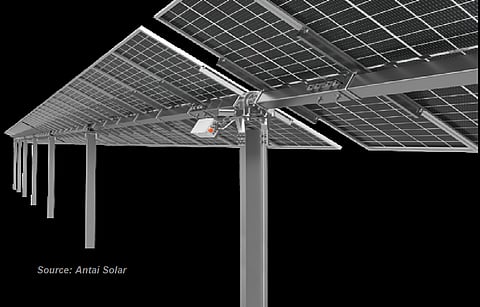

Solar trackers play an increasingly important role in the growing field of large utility-scale PV, as they enable generally the lowest LCOEs. Acknowledging the importance of trackers, TaiyangNews has published its 2nd market survey on solar trackers — and the key finding of the survey will be published in a series of articles. We are starting with the introduction below.
Note, that the term "tracker(s)" in the survey mainly refers to the single-axis tracker unless mentioned otherwise as single-axis trackers are inexpensive, easy to set up, and operate at a minimal cost. Single-axis trackers, given their longer lifespan, outperform dual-axis trackers in terms of reliability. They are also ideal for businesses looking for a low-cost solution. According to Antai, single-axis trackers command a market share of more than 95%.
In fact, trackers are becoming the new state of the art in larger utility applications – the largest section of PV. The use of trackers in utility scale applications is growing exponentially, says Trina Trackers. Trackers account for more than 40% of the global PV ground-mount market and the share is expected to further grow in view of its significant BOS increase and technology improvements, according to Clenergy. Gonvarri Solar Steel estimates that trackers account for 25% of global solar PV deployments.
Trackers are increasingly preferred in combination with bifacial, which is becoming the technology of choice for utility-scale PV. In fact, the deployment of bifacial is growing rapidly. The application of bifacial in trackers has reached more than 95%, according to Clenergy. Gonvarri says that most of its current projects involving trackers are with bifacial modules.
There have also been several developments in the trackers segment of late. Trina Trackers says that the tracker industry is continuously working on designs and applications that make the installation of trackers easy and profitable at sites that would never be considered in the past because of their geographical and/or weather characteristics. Thus, the company expects the segment to continue to grow given government policies point the power industry towards independence from traditional and limited energy sources and a net-zero environment. Besides, as the industry focuses on integrating AI with trackers to achieve higher energy production and minimum LCOE at any site location, installing trackers is now more attractive than ever.
Limited land availability and growing power demand have also created a congenial environment for ancillary devices such as trackers that enhance the power output of modules. According to Antaisolar, trackers can help boost power by up to 20%. FTC adds one more point to this: increased module prices. The use of trackers helps realize the target power of the project using relatively fewer modules compared to the fixed-tilt mounting.
The applications for trackers are also increasing; for example, agrivoltaics (ag-PV). Trackers enable the integration of farming with power generation very effectively. Trackers not only improve yields, they also help in shaving noon peaks, thus avoiding negative tariffs. This approach is called as Anti- Tracking, which is nothing but turning the solar panels away from the sun in a closed-loop control manner. It smartly avoids the energy dissipation but restricts production. Agrovoltaics is a promising segment – and has triggered the use of trackers in a few European countries that were not favorable for trackers in the past.
The text is an excerpt from TaiyangNews Market Survey on Solar Trackers, which can be downloaded for free here.
.png?w=50&fm=png)